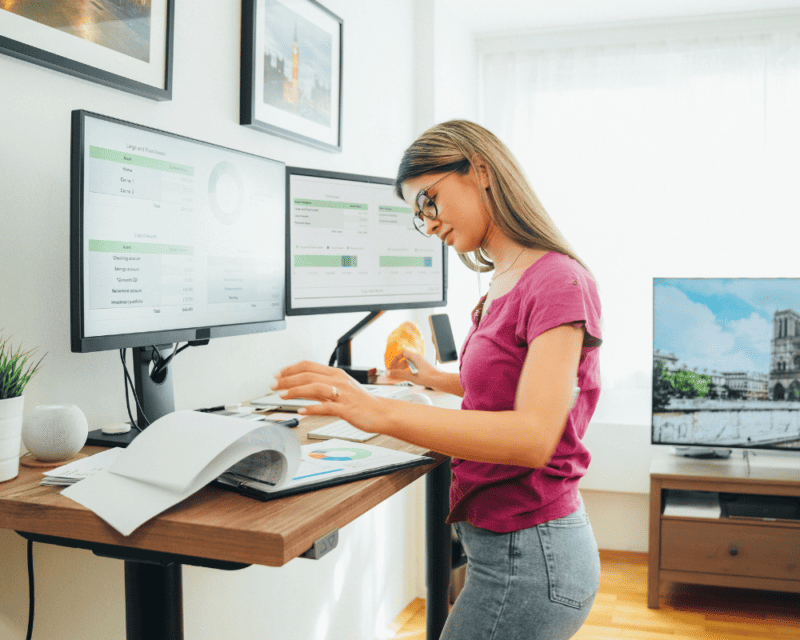While the flexibility of working from home brings numerous advantages, it also introduces challenges, particularly in curating the optimal working environment. Prolonged hours in front of a computer can take a toll on our bodies, especially if you’re reluctant to invest in the right equipment. In this comprehensive guide, we’ll explore practical tips and strategies for looking after your posture and promoting overall well-being while navigating working from home.
Creating Your Home Office Haven

Establishing an ergonomic workspace is the first step towards safeguarding your posture. Invest in a comfortable office chair that supports the natural curve of your spine and aligns with your desk at the correct height. Ensure your computer screen is at eye level to prevent unnecessary strain on your neck. This foundational setup forms the basis for a posture-friendly home office.
The Core of Good Posture
Mindful sitting is the cornerstone of maintaining good posture, especially when working from home. Pay attention to how you sit in your chair. Keep your feet flat on the ground, your knees forming a 90-degree angle, and your back comfortably supported by the chair. Avoid slouching or leaning forward, as these habits can contribute to discomfort and strain on your back and neck.
Take Regular Breaks
Working from home makes it easy to get engrossed in tasks for extended periods. Combat the passive nature of remote work by incorporating regular breaks into your routine. Stand up, stretch, and walk around every hour. These brief intervals of movement refresh your mind, prevent stiffness, and promote blood circulation, contributing to better posture.
Stretching and Strengthening Exercises

Integrate simple stretching and strengthening exercises into your daily routine to enhance your posture. Target neck, shoulders, and lower back to alleviate tension. Incorporate exercises that engage your core muscles, as a strong core is fundamental to maintaining an upright posture. Short, focused workouts or stretches during breaks can make a significant difference over time.
The 20-20-20 Rule: Rest for Your Eyes and Body
Extended screen time can strain not only your posture but also your eyes. Implement the 20-20-20 rule: every 20 minutes, look at something 20 feet away for at least 20 seconds. This simple practice helps reduce eye strain and allows your body to readjust. It’s a small investment with significant returns for your eyes and overall posture.
Maintain Proper Lighting

Effective lighting is often underestimated but is crucial in maintaining good posture. Position your workspace to take advantage of natural light, and use ambient lighting to reduce glare on your screen. Adequate lighting supports your visual comfort and contributes to an overall positive work environment, enhancing your focus and posture.
Invest in Ergonomic Accessories
Explore ergonomic accessories designed to enhance your home office experience. Consider investing in a laptop stand to elevate your screen to eye level, an external keyboard to maintain proper hand and arm positioning and a mouse that minimises wrist strain. These tools can be valuable allies in creating a workspace that prioritises comfort and posture.
Stay Hydrated
Hydration is a key factor in supporting your body’s ability to maintain good posture. Dehydration can lead to stiffness and discomfort, affecting your ability to sit comfortably for extended periods. Keep a water bottle within reach, and make a conscious effort to stay hydrated throughout the day. Your body will thank you with improved flexibility and overall well-being.
Consider a Standing Desk

Consider incorporating a standing desk into your home office setup if space allows. Standing desks offer a dynamic alternative to prolonged sitting, promoting better circulation and reducing the risk of musculoskeletal issues. Experiment with sitting and standing throughout the day to find a balance that suits your work style and posture preferences.
Nurturing Your Posture When Working From Home
In the evolving landscape of remote work, prioritising your posture is an investment in your long-term well-being and productivity. By cultivating an ergonomic home office, practising mindful sitting, incorporating regular breaks, and integrating supportive habits, you can create a workspace that facilitates productivity and nurtures your physical health.
Remember, the key is consistency. Implementing these strategies gradually and making them a part of your daily routine will contribute to the sustainability of good posture habits. Although purchasing an office chair for home can be an expensive investment initially, the benefits for your physical and mental wellbeing far outweigh the cost. Your home office should be a haven that promotes productivity and overall wellness. As you navigate the challenges of remote work, let your commitment to posture care guide you towards a healthier and more comfortable work-from-home experience.
